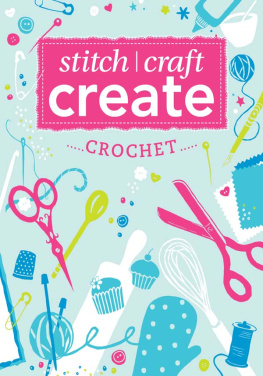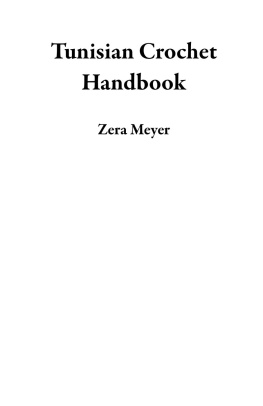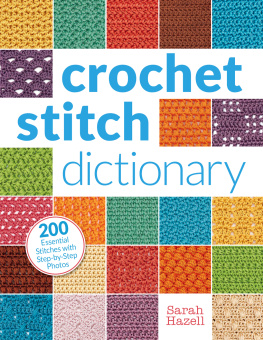Alice Bell - How to Crochet for Intermediates
Here you can read online Alice Bell - How to Crochet for Intermediates full text of the book (entire story) in english for free. Download pdf and epub, get meaning, cover and reviews about this ebook. year: 2015, publisher: Alice Bell, genre: Home and family. Description of the work, (preface) as well as reviews are available. Best literature library LitArk.com created for fans of good reading and offers a wide selection of genres:
Romance novel
Science fiction
Adventure
Detective
Science
History
Home and family
Prose
Art
Politics
Computer
Non-fiction
Religion
Business
Children
Humor
Choose a favorite category and find really read worthwhile books. Enjoy immersion in the world of imagination, feel the emotions of the characters or learn something new for yourself, make an fascinating discovery.
- Book:How to Crochet for Intermediates
- Author:
- Publisher:Alice Bell
- Genre:
- Year:2015
- Rating:3 / 5
- Favourites:Add to favourites
- Your mark:
- 60
- 1
- 2
- 3
- 4
- 5
How to Crochet for Intermediates: summary, description and annotation
We offer to read an annotation, description, summary or preface (depends on what the author of the book "How to Crochet for Intermediates" wrote himself). If you haven't found the necessary information about the book — write in the comments, we will try to find it.
With this book you will learn:
Get Started Today Improving Your Crochet Skills!
How to Crochet for Intermediates — read online for free the complete book (whole text) full work
Below is the text of the book, divided by pages. System saving the place of the last page read, allows you to conveniently read the book "How to Crochet for Intermediates" online for free, without having to search again every time where you left off. Put a bookmark, and you can go to the page where you finished reading at any time.
Font size:
Interval:
Bookmark:
How To Crochet For Intermediates
Crochet, Volume 2
Alice Bell
Published by Alice Bell, 2015.
While every precaution has been taken in the preparation of this book, the publisher assumes no responsibility for errors or omissions, or for damages resulting from the use of the information contained herein.
HOW TO CROCHET FOR INTERMEDIATES
First edition. March 3, 2015.
Copyright 2015 Alice Bell.
ISBN: 978-1502279576
Written by Alice Bell.
10 9 8 7 6 5 4 3 2 1
Also by Alice Bell
Crochet
How To Crochet For Intermediates
Crochet Patterns Guide
(2 Book Bundle) "How To Crochet For Beginners" & "How To Crochet For Intermediates"
(2 Book Bundle) "How To Crochet For Beginners" & "Crochet Patterns Guide"
(2 Book Bundle) "How To Crochet For Intermediates" & "Crochet Patterns Guide"
(3 Book Bundle) "How To Crochet For Beginners" & "How To Crochet For Intermediates" & "Crochet Patterns Guide"
M any years ago, a series of books were published that expounded on the traditions, arts and overall life of those living in the Appalachia. It was the Foxfire series. And, for those of you who don't know where the Appalachia is, it is the section of the United States that spans from New England into North Georgia. Yep, the Appalachian Trail rings a bell doesn't it? In those books, students from a private school in Northeast Georgia, Rabun Gap - Nachoochee School to be exact, went in search of the mountain folk....those of the Appalachia....mostly those of the Irish descent...to ask them how they survived, lived and flourished. What they learned, much to their surprise, was that providing for their families, making things out of available goods and living a good life was what it was all about. They learned of making the only musical instrument that is native to this country, the dulcimer. They learned about hand-hewn logs for making just about anything they needed made of wood. But also among those learned traditions was needle-art, including but not limited to crocheting.
While I do not come from that group of people (except maybe the Irish portion) interviewed by these students, I can relate to the concept. Coming from the South and a time when family was more important that watching the latest and most popular sitcom, I can remember sitting at my grandmother's knee as she rocked back and forth crocheting to the rhythm of her rocking all the while showing me how to crochet at a very young age. I really don't believe that my grandmother could have crocheted quite as well if she hadn't been in her rocker! As a child I recall thinking that winding my grandmother's threads and yarns into balls was really cool! And she had such really neat stuff in her crochet basket; hairpin lace shuttles, tatting shuttles, tapestry needles in little glass vials, and what I thought was a gazillion crochet hooks. It's no wonder that my interest in the needle-arts became such a passion. My very first project was the infamous granny square. I made my first small afghan at about 8 years of age from my grandmothers' scraps. As I grew older, she showed me more and more about crocheting and needle arts in general. The first time I made Hairpin Lace, I was thrilled at how I could take that tiny thread and shuttle, with a crochet hook, and make all that lovely lace. I still have a trunk full of needle-art magazines and directions dating back to the 1920's that my grandmother, and mother, used for making everything from household items to clothing. Looking back through those books is a trip through history, as it helps one to understand that making things for your family was a way of life. It wasn't just about cooking, cleaning and such; it was about providing your family with those little extras that, in those days, most could not afford.
Crocheting through the years has evolved, which is obvious by looking at today's books and catalogs. We all started as beginners, just little novices in a world of hooks and yarns. But working our way through that forest of choices, we have grown and evolved, just as did crochet. We are a part of that evolution and with each passing year, it's our work and creations that keep it alive and in the hearts and homes of people just like you. Remember that no matter what skill level you achieve, sharing that knowledge with your family and children will be an experience that will stay with them for a lifetime. Imagine what it would be like today, if no one had done that centuries ago? What a wonderful experience we would be missing indeed!
C rocheting obviously began long before those days of the folks in Appalachia and as all needle-art is timeless, passed on through the generations of how to take an ordinary thread and by looping it over a hooked needle, transform it into something wonderfully magnificent. From delicate laces (including Irish crochet, or linen lace) for attaching to either clothing or household articles, to clothing and much, much more. It's no wonder that according to the website www.crochet.org, the Crochet Guild of America (CGOA) notes that modern crochet as we know it was developed in the 16th century thus continuing to have a long line of evolution down to today.
In this book, we won't be making Hairpin Lace or Irish Linen Lace, but we will concentrate on the intermediate level crochet style. Basic stitches are just that; chain stitches, slip stitch, double and/or treble stitch are usually in a simple basic application, such as making a granny afghan square. Intermediate crocheting will carry you into a new variety of stitches and patterns in your work. We will give you an introduction to a few fun stitches to learn, such as the Afghan Stitch or Tunisian, Shell, Popcorn, Lover's Knot, Tapestry and even a brief discussion of Irish Lace. Utilizing the intermediate stitches, you will discover how changing stitches, media and style throughout your work will allow you to create more detail, such as a lacy look or just simply a pattern effect. There are various types of crochet, determined by what you desire to accomplish. From heavier yarns and fabrics to super-fine threads, the selections are unending. Choosing the proper size hook for your project is also dependent on the media and item you have chosen to make.
Consider all the things you can make for you, your family, and your home. Nothing can beat that feeling of accomplishment that you have when you have completed your project. You will have completed a project using methods that existed hundreds, possibly thousands, of years ago. A project using your hands, a hook, threads or yarn and a pattern or an impression of what can be. Your options are endless in that respect!
S o, you are ready for more advanced, or intermediate, crochet. Hopefully, once you have become comfortable with these few stitches, your limitations of crochet are over. These are the basics; everything else is just a variation of the simple. Basic crochet stitches are simple enough for a child to learn and at very early age. All they need is a little determination, a little coordination, and the drive to make it happen. If you can accomplish these few tasks, you will be moving onto the Intermediate level quickly. ( These instructions are assuming you are right-handed.)

T his is the base of all crochet. First, make a slip-knot, and then grasp it in your left hand. The knot should be facing you at this point. Secure the tail of the yarn with your thumb so that it is directly below the slip knot. Assuming that the yarn that is coming directly from the ball, it should flow over your index finger. You will then use your middle finger, fourth finger, and pinkie to manipulate the yarn as you crochet. (And just a note from experience; you don't have to make a ball out of your yarn, as most yarns come in pull-skeins. However, pull-skeins often get to a point of knotting and may cause you to alter your tension as you pull yarn. Pulling from a ball will give you a more even tension and flow of yarn.)The crochet hook should face upwards once entered in the slip knot. You will rotate it by a one-quarter turn counterclockwise with each chain stitch that you crochet. You should make each motion as precise and fluid as possible. While the crochet hook is still inside the slip knot, slide the hook in between your yarn and the index finger on your left hand. Rotate your crochet hook by about one quarter turn counterclockwise, and use your middle finger, fourth finger, and pinkie to help you manipulate the yarn so that you can easily grab it with the crochet hook. Then, simply draw the yarn through the slip knot. To make another chain stitch, insert the hook again into another loop and draw it through. Repeat as many times as necessary. You should guide the chain stitches in a downward motion as you crochet. As everybody crochets differently, you may find that holding your work and your hook differently is more comfortable.
Font size:
Interval:
Bookmark:
Similar books «How to Crochet for Intermediates»
Look at similar books to How to Crochet for Intermediates. We have selected literature similar in name and meaning in the hope of providing readers with more options to find new, interesting, not yet read works.
Discussion, reviews of the book How to Crochet for Intermediates and just readers' own opinions. Leave your comments, write what you think about the work, its meaning or the main characters. Specify what exactly you liked and what you didn't like, and why you think so.














